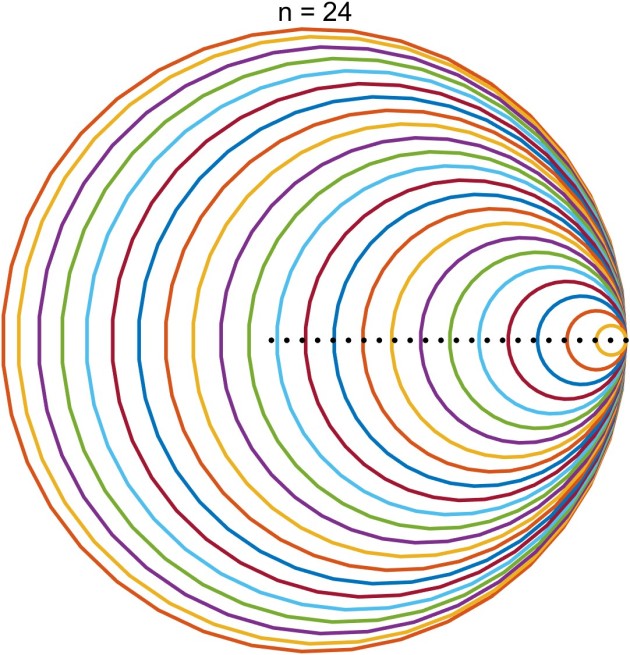For an matrix
with nonsingular block
the Schur complement is
. It is denoted by
. The block with respect to which the Schur complement is taken need not be the
block. Assuming that
is nonsingular, the Schur complement of
in
is
.
More generally, for an index vector , where
, the Schur complement of
in
is
, where
is the complement of
(the vector of indices not in
). Most often, it is the Schur complement of
in
that is of interest, and the general case can be reduced to it by row and column permutations that move
to the
block of
.
Schur Complements in Gaussian Elimination
The reduced submatrices in Gaussian elimination are Schur complements. Write an matrix
with nonzero
element
as
This factorization represents the first step of Gaussian elimination.
After stages of Gaussian elimination we have computed the following factorization, in which the
blocks are
:
where the first matrix on the left is the product of the elementary transformations that reduce the first columns to upper triangular form. Equating
and
blocks in this equation gives
and
. Hence
, which is the Schur complement of
in
.
The next step of the elimination, which zeros out the first column of below the diagonal, succeeds as long as the
) element of
is nonzero (or if the whole first column of
is zero, in which case there is nothing to do, and
is singular in this case).
For a number of matrix structures, such as
- Hermitian (or real symmetric) positive definite matrices,
- totally positive matrices,
- matrices diagonally dominant by rows or columns,
-matrices,
one can show that the Schur complement inherits the structure. For these four structures the element of the matrix is nonzero, so the success of Gaussian elimination (or equivalently, the existence of an LU factorization) is guaranteed. In the first three cases the preservation of structure is also the basis for a proof of the numerical stability of Gaussian elimination.
Inverse of a Block Matrix
The Schur complement arises in formulas for the inverse of a block matrix. If
is nonsingular, we can write
If is nonsingular then inverting gives
So is the
block of
.
One can obtain an analogous formula for in terms of the Schur complement of
in
, in which the inverse of the Schur complement is the
block of
. More generally, we have
.
Test for Positive Definiteness
For Hermitian matrices the Schur complement provides a test for positive definiteness. Suppose
with positive definite. The factorization
shows that is congruent to the block diagonal matrix
, and since congruences preserve inertia (the number of positive, zero, and negative eigenvalues),
is positive definite if and only if
is positive definite, that is, if and only if
is positive definite. The same equivalence holds with “definite” replace by “semidefinite” (with
still required to be positive definite).
Generalized Schur Complement
For in (1) with a possibly singular
block
we can define the generalized Schur complement
, where “+” denotes the Moore-Penrose pseudo-inverse. The generalized Schur complement is useful in the context of Hermitian positive semidefinite matrices, as the following result shows.
Theorem 1.
If
is Hermitian then
is positive semidefinite if and only if
and
and the generalized Schur complement
are both positive semidefinite.
If is positive definite then the range condition is trivially satisfied.
Notes and References
The term “Schur complement” was coined by Haynsworth in 1968, thereby focusing attention on this important form of matrix and spurring many subsequent papers that explore its properties and applications. The name “Schur” was chosen because a 1917 determinant lemma of Schur says that if is nonsingular then
which is obtained by taking determinants in (2).
For much more about the Schur complement see Zhang (2005) or Horn and Johnson (2013).
- Emilie V. Haynsworth, Determination of the Inertia of a Partitioned Matrix, Linear Algebra Appl. 1(1), 73–81, 1968.
- Roger A. Horn and Charles R. Johnson, Matrix Analysis, second edition, Cambridge University Press, 2013. My review of the second edition.
- Fuzhen Zhang, editor, The Schur Complement and Its Applications. Springer-Verlag, New York, 2005, xvi+295 pp.
Related Blog Posts
- What Is a Block Matrix? (2020)
- What is a Diagonally Dominant Matrix? (2021)
- What Is a Symmetric Positive Definite Matrix? (2020)
- What Is a Totally Nonnegative Matrix? (2021)
- What Is an LU Factorization? (2021)
- What Is an M-Matrix? (2021)
- What Is the Inertia of a Matrix? (2022)
- What Is the Matrix Inverse? (2022)
This article is part of the “What Is” series, available from https://nhigham.com/category/what-is and in PDF form from the GitHub repository https://github.com/higham/what-is.



 Here are two other matrices whose Gershgorin discs make a graphically interesting plot.
Here are two other matrices whose Gershgorin discs make a graphically interesting plot.

